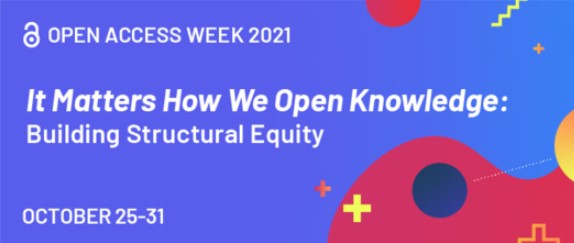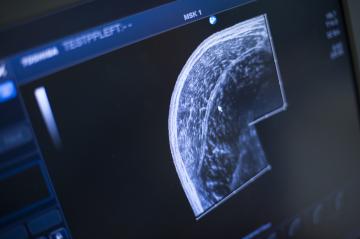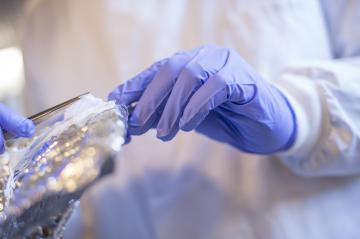
October 25, 2021, by Kate Snaith
Open Software and Preprints – an interview with Professor Chris Denning
Welcome to International Open Access Week 2021! Join us on Library Matters throughout the week as we share daily insights into the wonderful world of open access. Our first blog is an interview with Professor Chris Denning.
Chris Denning (ORCiD: 0000-0003-0802-8617) (orcid.org) is a Professor in Stem Cell Biology. He leads the University’s Research Priority Areas in Regenerative Medicine & Stem Cells, and in End to End Therapeutics. From 2018, he became Director of University of Nottingham Biodiscovery Institute (BDI), which is a cluster of buildings engaged in highly interdisciplinary activities ranging from regenerative medicine and cancer, through to drug discovery, antimicrobials and industrial biotechnology.
In this blog post, Chris expands on the Open Research practices associated with two recent and significant research projects.
Q. Back in 2017, you collaborated with Leiden University, and others, to generate an automated open-source software tool (MUSCLEMOTION). What was Musclemotion originally designed to do, and for whom?
The concept of MUSCLEMOTION was simple: To quantify the amount of contraction of hearts or heart cells. The software was developed with anyone in the field of cardiology and cardiovascular disease, irrespective of whether they work in fundamental science (cell, tissues, organs) through to clinical diagnostics.
The software simply measures pixel intensity from one frame to the next of videos captured of beating heart cells or hearts. The algorithm calculates these intensity changes across millions of pixels over videos of 1,000 frames or more. It converts these changes into waveforms, from which contraction parameters can be calculated
The upshot is that changes can be measured in the contraction of heart or heart cells when they are subjected to drug challenge or disease status.
The original work showed the software worked in heart cells in culture derived from animals or humans, from stem cells and from organoids. In addition, data were derived to show the software could detect changes in mutant hearts from animal models such as zebrafish and mice, and from clinical imaging data from patients with diseases such as hypertrophic cardiomyopathy.
Q. What did the project team anticipate would happen with Musclemotion after the software was published?
Up to the point of publishing our software, there was no provision for ‘cheap’ analysis methods, which was restrictive to the growth of the field. For example, companies that produced hardware costing circa £200,000 would integrate the software into the machines. So, researchers could only access the software if they had the money to buy the hardware.
Our ambition was two-fold:
- Provide freely-available open access software to allow anyone in the field to measure contraction rather than only those who could afford expensive equipment.
- Provide the source code so that programmers could improve it to create the next generation(s) of software.
Q. What happened next?
First, by publishing the work early via Open Access in the BioRVIX pre-print server, we were able to connect with the community quickly. Only about a year later did we get the work published in a top level journal, Circulation Research.
We were delighted to get contact from people across several continents – four, I think (North America, South America, Europe and Australasia) – asking for assistance in how to use the software. This meant the software engineers (i.e. not me, I’m far too dim to be able to programme code..!) could put together a ‘how to’ handbook.
Next, we encouraged people to use different video recording options. The aim was to get to the position where a £20 product from Amazon could be used to connect a SmartPhone to the eyepiece of a microscope to record at high frame rate (>120 frames per second) of beating cells. These videos could be used for MUSCLEMOTION and meant that most researchers could achieve this with a £20 gadget rather than a £200,000 gadget.
The ‘parent project’ that funded this work was in collaboration with GSK. These kinds of outputs encouraged GSK to provide further funding into a BBSRC iCASE studentship, which is currently running until October 2023. The software engineers at GSK have developed our Open Access source code to create their own next generation software, CardioMotion. Moreover, the combination of approaches around Open Access code and publications was a key factor in GSK replacing one of their animal experimental models using rabbits for drug induced cardiotoxicity with the stem cell derived models coupled with CardioMotion.
We have since won a joint award with AstraZeneca supported by Animal-Free Research UK and we are currently recruiting a postdoc to this grant, which will run 2022-2025
Q. Jumping now to 2020 you spearheaded the Pilot Project that would become the University of Nottingham Asymptomatic Testing Service for Covid-19. What scientific finding or breakthrough moment are you most proud of from this project, either from the pilot stages or later on?
Three things spring to mind.
First, getting to the stage of being the first institute in the UK to gain ‘recommended for accreditation’ status for a SARS-CoV-2 PCR assay based on saliva and the first University in the country to gain this recognition is a real highlight. It provides validation that testing does not need to be synonymous with the pain of the swab test and that non-invasive donation of saliva is perfectly adequate.
Second, getting to the stage of running pilots to see whether the user community prefers our saliva test to government swab tests – by the community, I mean children in disadvantaged schools and an institute for the blind, along with active discussions of supporting care homes and hostels for the homeless.
Finally, during October/November 2021, the testing service will pass the 100,000 sample marker, with samples provided from more than 20,000 people
The findings from the Pilot were shared on the preprint server, MedRxiv.
Q. What was the motivation at the time to share this preprint?
Speed is the primary reason. With conventional journals, the peer review process can be unduly long.
In our case, our first SARS-CoV-2 publication was published in pre-print in August 2020. However, the peer-reviewed article didn’t appear online until quarter 1 in 2021, so a lag of 6 months in a field that was changing by the day.
Q. What did the project team anticipate would happen after the preprint was uploaded?
Our hope was to maximise exposure of the lab and, if you like, put a stamp down that we were able to streamline NHS testing services. But perhaps more importantly, to convince the University to part with an initial tranche of £2m in funding to set up the University of Nottingham Covid-19 Asymptomatic Testing Service – and in this, we succeeded.
Q. What happened next?
Several things, really. Getting the University of Nottingham to provide substantial funding triggered an explosion of activity – funding was approved on 2 September 2020 and we were expected to go from empty labs with no equipment, reagents or people to fully operational in less than 4 weeks.
We went live on 28 September 2021, even though many said that timeline was impossible. But because we had worked hard to build a strong research culture within the Biodiscovery Institute, we were able to tap into this positivity and set the service up fast.
We were also able to build an alliance between the University of Nottingham and The Francis Crick Institute (CRICK) specifically Rupert Beale, who was leading their Covid-19 testing programme. This meant that UoN and the CRICK became the co-founders of the University Expert Group, which quickly developed into a national initiative with all major UK universities who met weekly with government to steer policy – including the Cabinet Office, Department for Health & Social Care, and Department for Education. It was around this time that the government switched from only testing symptomatic cases to a broader programme of asymptomatic testing
Finally, the pre-print helped with our primary publication. With the field moving so quickly, others were publishing the area. The reviewers noted this and but acknowledged that because our work had been published in pre-print we had had not been ‘pipped to the post’, and so was happy for our article to be published in the peer-reviewed Journal of Medical Microbiology. I had not experienced this before and my lab now frequently uses the pre-print route.
Q. Reflecting on these two experiences of Open Research practices, have they contributed to a change in your outlook and/or way of working?
I was sceptical of pre-prints but I am now a convert. Unless there is a very specific reason not to go pre-print (perhaps industrial confidentiality, patenting or impacting on a major publication), I would always, at the very least, consider whether pre-print should be my initial route. I have done so about five times recently and not experienced any negative consequences – indeed, so far I have only seen benefits.
Thank you to Professor Chris Denning for sharing his thoughts on Open Research. Follow the Library Matters blog throughout International Open Access Week for more great insights into the benefits of open research.
For more information about open access, please visit the Libraries website.
No comments yet, fill out a comment to be the first




Leave a Reply